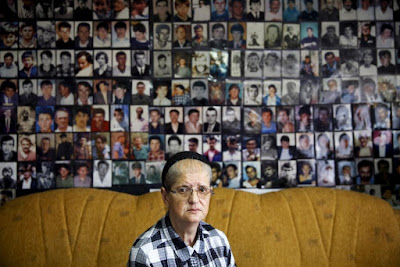The term Bosnian Genocide refers to either genocide at Srebrenica and Žepa committed by Bosnian Serb forces in 1995 or the wider ethnic cleansing campaign throughout areas controlled by the Army of the Republika Srpska that took place during the 1992–1995 Bosnian War.
The events in Srebrenica in 1995 included the killing of more than 8,000 Bosniak ("Bosnian Muslim") men and boys, as well as the mass expulsion of another 25,000–30,000 Bosniak civilians, in and around the town of Srebrenica in Bosnia and Herzegovina, committed by units of the Army of the Republika Srpska (VRS) under the command of General Ratko Mladić.
The ethnic cleansing campaign that took place throughout areas controlled by the Bosnian Serbs and targeted Muslim Bosniaks and Bosnian Croats. The ethnic cleansing campaign included unlawful confinement, murder, rape, sexual assault, torture, beating, robbery and inhumane treatment of civilians; the targeting of political leaders, intellectuals and professionals; the unlawful deportation and transfer of civilians; the unlawful shelling of civilians; the unlawful appropriation and plunder of real and personal property; the destruction of homes and businesses; and the destruction of places of worship.
In the 1990s, several authorities asserted that ethnic cleansing as carried out by elements of the Bosnian Serb army was genocide. These included a resolution by the United Nations General Assembly and three convictions for genocide in German courts, (the convictions were based upon a wider interpretation of genocide than that used by international courts). In 2005, the United States Congress passed a resolution declaring that "the Serbian policies of aggression and ethnic cleansing meet the terms defining genocide".
However, in line with a majority of legal scholars, the International Criminal Tribunal for the Former Yugoslavia (ICTY) and the International Court of Justice (ICJ) have ruled that, in order for actions to be deemed genocide, there must be physical or biological destruction of a protected group and a specific intent to commit such destruction. To date, only the Srebrenica massacre has been found to be a genocide by the ICTY, a finding upheld by the ICJ. Former Bosnian Serb leader Radovan Karadžić is currently on reinstated charges for genocide in several Bosnian municipalities other than Srebrenica, a verdict is not expected before 2015.
Death toll
If a narrow definition of genocide is used, as favoured by the international courts, then during the Srebrenica massacre, 8,000 Bosnian Muslim men and boys were murdered and the remainder of the population (between 25,000 and 30,000 Bosniak women, children and elderly people) was forced to leave the area. If a wider definition is used, then the number is much larger. According to the ICTY Demographic Unit, an estimated 69.8% or 25,609 of the civilians killed in the war were Bosniak (with 42,501 military deaths), with the Bosnian Serbs suffering 7,480 civilian casualties (15,299 military deaths), the Bosnian Croats suffering 1,675 civilian casualties (7,183 military deaths), amounting to a total of 104,732 casualties, spread between the Bosnian Croats (8.5%), Bosnian Serbs (21.7%), Bosniaks (65%), and others (4.8%).

















0 Comments